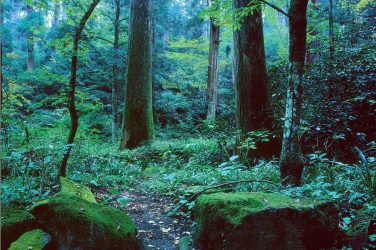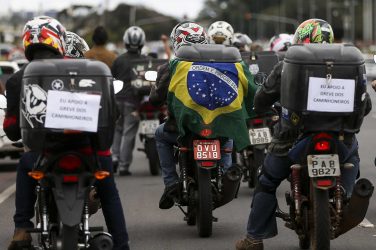Behind a narrow border of trees, a crop duster sprays clouds of agrochemicals onto the vast soy fields stretching out on both sides of the BR-319 highway that cuts deep into Brazil’s Amazon rainforest.
As the road’s asphalt wears thin further north, timber trucks zig-zag to avoid the many potholes along the key transport artery, which spans 885 km (550 miles) and has come to symbolize the tension between infrastructure projects and environmental protection in the world’s largest rainforest.
Linking Manaus, the capital of Amazonas state, and Porto Velho, Rondônia’s state capital, the road has lost most of its paving since it was built in the 1970s – meaning many sections are reduced to a muddy quagmire during the six-month wet season.
Now, as a series of droughts linked to climate change complicate river transport in the region, President Luís Inácio Lula da Silva’s government has vowed to repave the BR-319.
Amazon researchers fear repairing the road could trigger a surge in deforestation in Amazonas state, home to most of Brazil’s best-preserved rainforest, potentially threatening Lula’s progress on stemming forest loss to fight climate change.
But calls for rebuilding the road are growing louder.
Reading the ruins of Amazon fires, scientists see crisis ahead
During a record drought last year, farmers and residents had to rely on the BR-319 as the normally busy Amazon waterways sank to their lowest levels, making it almost impossible for shipping to navigate them.
Back in 2013, maintenance work resumed on the dirt portion of the road that runs through the district of Realidade, in Humaitá municipality, dramatically reducing the time it takes to reach the main city, and beyond. Paving work has not yet begun.
Humaitá mayor Dedei Lobo is happy – he expects an even harsher drought from May this year, so the road will be needed, especially as rivers are still below average levels.
Asked about environmental concerns over the road repairs, Lobo dismissed them as “a fad launched by NGOs financed by First World countries that have trains, subways, trams etc” while treating Amazon residents as “living in an altar”.
Environmental reserves already established around the BR-319 should halt deforestation, as long as the federal government reactivates abandoned enforcement checkpoints, he added.
But the Transdisciplinary Network of the Amazon (RETA), a collection of grassroots environmental groups from the area around the road, has said the work carried out on the BR-319 near Realidade is already driving up land prices.
This is fueling land-grabbing and deforestation, said Dionéia Ferreira, a RETA coordinator.
Environmentalists also fear that highway development leads loggers, farmers and land-grabbers to extend unauthorized side roads deeper into the forest in a pattern known as “fish bones” because of how the side roads look from space.
According to a 2023 analysis from the BR-319 Observatory, 5,092 km (3,100 miles) of illegal side roads have been built along the highway.
Vicious circle?
When he returned to power in 2023, Lula vowed to protect the Amazon but he also accepted a key demand of Brazil’s powerful farming lobby and many locals by promising to pave the BR-319 – at an estimated cost of some 2 billion reais ($385 million).
In December, the lower house of Congress approved a bill to relax environmental rules so that the BR-319 could be paved.
The draft law, which still needs Senate approval, authorizes the use of conservation funds donated to Brazil to finance the project, such as the $1.3 billion Amazon Fund backed by the U.S. and European allies.
The government plans to pave the road’s 406-km (250-mile) middle section by 2027, and in late April it launched a bidding process to pave a 20-km (12-mile) northern segment of the road, which has already obtained environmental licences.
Some analysts fear expanding roads in the fragile Amazon region could exacerbate the very problems that created the need for more land-based transport connections in the first place.
“Paving the road … also has effects on deforestation, which may elevate the risk of droughts,” said Carlos Souza Jr. from the Imazon environmental institute.
Road density in the Amazon increased 51% between 2012 and 2020, with roads now disturbing 55% of the forest’s area, according to a study from the Amazon Georeferenced Socio-Environmental Information Network (RAISG), a transnational consortium of Amazon environmental organizations.
In places like Realidade, not everyone thinks more deforestation would necessarily be a bad thing.
Sitting at a bus station beside the BR-319 in the district’s main village, coffee grower Norberto Lauret said deforestation “brings the daily bread in, and avoids people having to go live in big cities”, though he said forest clearance must be done in accordance with the law.
The process is well underway. Between 2012 and 2022, there was a 20-fold jump in annual deforestation in Humaitá, according to Brazil’s Institute for Space Research, consolidating the status of southern Amazonas state as a new frontier for agribusiness and forest loss.
Drawing farmers, Realidade attained district status in 2019 and now boasts small restaurants, farm shops, markets and evangelical churches.
Side roads and Satellite dishes
Advocates for repaving the BR-319 deny that the road has prompted deforestation.
“The road has been open for 50 years… and there has been no deforestation” in its unpaved central portion, congressman Coronel Chrisóstomo said at his office in Porto Velho, flanked by life-size cardboard cut-outs of himself and former far-right President Jair Bolsonaro.
Many of those most harmed by deforestation also see benefits in the paving of the BR-319, as side roads make remote areas more accessible.
They include the Linha 17, a side road that pushed out from Realidade in 2016, extending through traditional forest communities and, according to Ferreira from RETA, bringing loggers, land-grabbers and cattle ranchers into the interior.
As nut and açaí fruit groves were destroyed and erosion from deforestation muddied fishing grounds, the riverside Pirapitinga community saw its traditional sources of income decline, driving some to mine illegally for gold in the river.
Although uncontrolled deforestation is frowned upon, many in the community approve of Linha 17, which was used by the government to electrify the area last year.
“You can now get to Realidade with a motorcycle and shop in no time,” said forest collector and peasant farmer Cimião Alves, as he pointed to his satellite dish and an electric pump pulling water from the nearby river.
Despite the vote in Congress to allocate funds for the road paving project, questions remain over whether it will get the go-ahead from the Environment Ministry.
Last year, Environment Minister Marina Silva told Congress the road’s environmental and economic rationale has not yet been proven.
After selling properties elsewhere in the Amazon, farmer José Antônio de Freitas resettled in Realidade in 2010, attracted by larger plots in the new frontier.
He is confident that Lula will be able to push through the project, citing his past record on contentious Amazon infrastructure projects.
“Opponents do not think about growth and development,” he said. “If I pay taxes for a truck … then you have to give me the (road) conditions to drive it.”
Andre Cabette Fabio is Climate and Nature Correspondent for the Thomson Reuters Foundation based in Rio de Janeiro.
This article was produced by the Thomson Reuters Foundation. Visit them at https://www.context.news/





